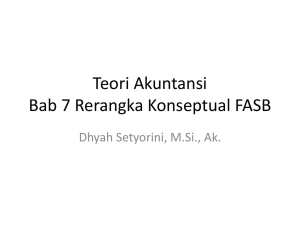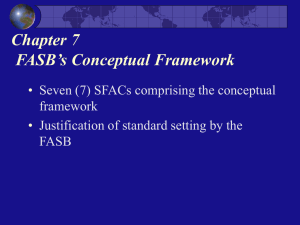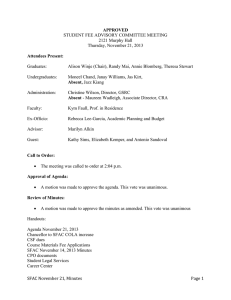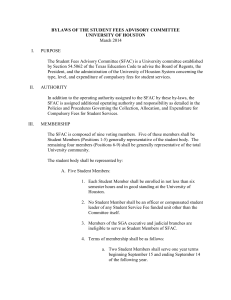Chapter 2
advertisement
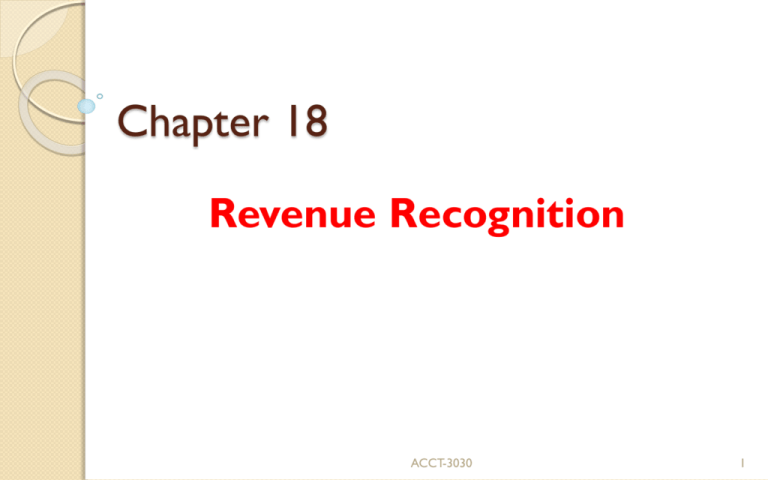
Chapter 18 Revenue Recognition ACCT-3030 1 1. Revenue Recognition Basic Concepts Definition of revenue (SFAC 6) ◦ Inflows or other enhancements of assets or settlement of liabilities during a period from delivering or producing goods, rendering services, or other activities that constitute the entity’s ongoing major or central operations. General recognition criteria (SFAC 5) ◦ ◦ ◦ ◦ meets definition of an element measurability relevance faithful representation ACCT-3030 2 1a. Revenue Recognition Basic Concepts APB Statement 4 ◦ Revenue is recognized when the earnings process is complete or virtually complete an exchange has taken place Realization principle (SFAC 5) ◦ Revenue is recognized when the earnings process is judged to be complete or virtually complete there is reasonable certainty as to the collectability of the asset to be received ACCT-3030 3 1a. Revenue Recognition Basic Concepts SEC SAB No. 101 ◦ persuasive evidence of an arrangement exists ◦ delivery has occurred or services have been rendered ◦ the seller’s price to the buyer is fixed or determinable ◦ collectability is reasonably assured ACCT-3030 4 2. General Rule Revenue is recognized at the point of sale Activity Revenue recognized when Selling products Point of sale (date of delivery; when title passes) Providing services Services have been performed and amounts are billable Permitting others to use the firm’s assets As time passes Disposing of assets Date of sale ACCT-3030 5 3. Possible Points to Recognize Revenue Most significant event Recognition before point of sale ◦ prior to starting production customer advances ◦ during production long-term construction contracts ◦ at completion of production precious metals, ag products Recognition at point of sale ◦ but if right of return exists or sale with buyback Recognition after point of sale ◦ cash collection methods installment sales, cost recovery basis ◦ consignments ACCT-3030 6 4. Expense Recognition Expense – expired economic benefits Outflows or other using up of assets or incurrence of liabilities during a period from delivering or producing goods, rendering services, or other activities that constitute the entity’s ongoing major or central operations. (SFAC 6) Expenses to be recognized can be identified by ◦ matching ◦ direct expensing (period costs) ◦ systematic allocation ACCT-3030 7 5. Revenue Frauds Obvious accounting violations ◦ Fictitious sales or fake customers ◦ Premature recording of sales ◦ Inflated sales Transactions lacking integrity ◦ ◦ ◦ ◦ Roundtrip transactions Channel stuffing and trade loading Bill and hold transactions Related party transactions Contracts, agreements and side letters ACCT-3030 8 6. Long-term Construction Contracts Percentage of completion method ◦ revenue recognized each period based on progress of construction ◦ this method required if costs to complete and extent of progress toward completion are reasonably dependable contract clearly specifies goods or services to be provided & received by parties buyer is expected to satisfy its contractual obligations contractor is expected to perform its contractual obligations ACCT-3030 9 6a. Long-term Construction Contracts Methods to estimate percentage of completion ◦ cost-to-cost method (input method) costs to date ÷ total estimated costs to complete most common method ◦ ◦ ◦ ◦ machine hours or labor hours (input measure) project milestones (output method) units of production (output method) engineer’s or architect’s estimates ACCT-3030 10 6b. Long-term Construction Contracts Revenue and GP recognized per period ◦ percentage completed this period x total revenue or GP ◦ new accounts construction in progress (inventory account) progress billings (contra acct to CIP) ◦ financial statement presentation net both accounts – could be debit or credit balance ◦ example ACCT-3030 11 7. Completed contract method Revenues and gross profit recognized when project finished Entries ◦ same entries to record costs and billings ◦ do not recognize revenue and gross profit each year The two methods are not acceptable alternatives Example ACCT-3030 12 8. Right of Return Only recognize revenue if all of following are met (SFAS 48) ◦ sellers price is fixed ◦ buyer has paid or is obligated to pay ◦ buyer’s obligation would not be changed by the theft or destruction of the product ◦ buyer has economic substance apart from that provided by the seller ◦ seller doesn’t have future significant obligations ◦ amount of future returns can be reasonably estimated ACCT-3030 13 9. Cash Collection Methods Emphasis placed on collection rather than on sale APB 10 ◦ generally states both methods are not acceptable ◦ but in certain exceptional circumstances may be used ACCT-3030 14 9a. Cash Collection Methods Installment Sales Method ◦ Emphasis placed on collection rather than on sale revenue recognized in periods of collection more important method for tax than fin acct ◦ Example ACCT-3030 15 9b. Cash Collection Methods Cost recovery method ◦ No gross profit recognized until all costs have been recovered ◦ After all costs recovered all additional cash received recorded as profit ◦ Example ACCT-3030 16 10. Multiple Deliverables Revenue must be allocated to various elements based on FMVs if they are separable Considered separable if ◦ items have value on a stand-alone basis ◦ there is a general right of return ◦ delivery is considered probable Examples ◦ IT equipment and software ◦ franchises ACCT-3030 17







